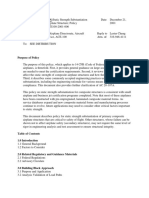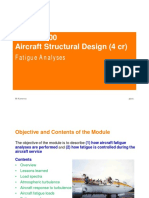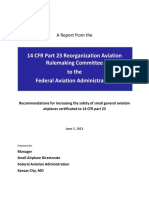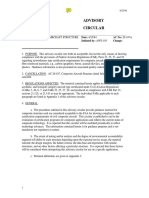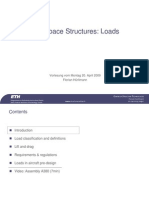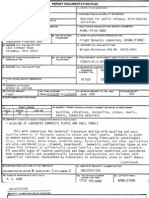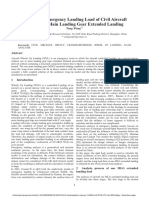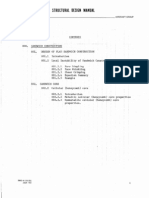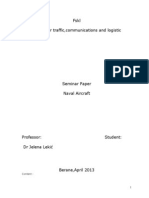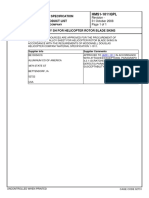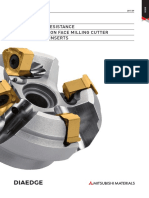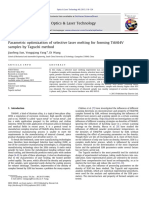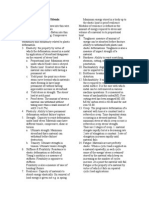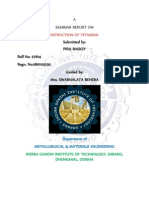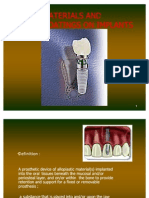Extreme Aircraft Structures
Extreme Aircraft Structures
Extreme Aircraft Structures
1
� Aircraft Structures - Like No Other Structure!
B-52 wing flexes 10 feet down (on ground) to 22 feet
up (in flight) - the span is 185 feet
The Concordes Aluminum alloy frame stretches 7
inches during flight due to aerodynamic heating
Space shuttle Columbia failed in flight due to a
breach in the wings leading edge during the
hypersonic flight phase - the internal aluminum
structure melted and the wing sheared off
All wings not only bend in flight, but also twist, from
aerodynamic loads leading to a change in
aerodynamic forces coupled with wing aeroelasticity
Safety factor for aircraft is typically 1.2-1.5, for
bridges and buildings it is typically >3, can be 10+!
2
� Aircraft Structures
The structure must meet a number of conflicting
requirements, namely
Low weight
Acceptable material and manufacturing costs
Adequate strength to meet maximum expected loads
with a suitable safety margin
Adequate stiffness so that bending, torsion, and other
distortions are kept within acceptable limits
Adequate in-service properties such that fatigue,
corrosion, cyclical heating and pressurization, etc., do
not result in structural failure
Example: North American F-86H Sabre
3
�Example: General Aviation
Example: JSF
4
� Example: A-380
Weight
Structural weight for manned vehicles typically
around 30% across a large range of aircraft - scales
with GTOW
Stinson
5
� cf. Cost of Aircraft
Specific cost (cost by weight)
Commercial aircraft: $50,000,000/50,000 lbs ~ $200/kg
Advanced stealth aircraft: $1,000,000,000/330,000 lbs ~ $50,000/kg
Diamonds: $1,000/carat ~ $50,000,000/kg
Electricity: $.07/kW-hr ~ $1.7x1054/kg
Weight
Need to assure structural integrity while minimizing
cost, so how much to save?
Why?
Saving weight means more
Payload (passengers, satellites, etc.)
Fuel (longer range, endurance)
Amount industry (civilian) is willing to pay to save a
pound of weight
Automobiles $0
General Aviation $25
Transport $100-200
Satellites $10,000-$20,000+
6
� Regulations
Aircraft structures are regulated by FAA Federal
Aviation Regulations (FARs)
FAR Part 23: GTOW < 14,000 lbs
FAR Part 25: GTOW > 14,000 lbs
FAR Part 29: Rotary Wing Aircraft
FAR Part 21: Experimental Aircraft
FAR Part 103: Ultralights, GTOW < 155 lbs (unpowered) or
GTOW < 254 lbs (powered)
UAVs?
No current FAR, use Part 103 until further notice
Forces (Loading) on Aircraft
Forces from pressurization (cabin, cockpit)
Forces in level and steady flight
Forces in attitude varying flight
Forces imparted by control surfaces, flaps
Forces imparted by gusts
Forces on doors, gear
Forces due to rapid change in weight
7
� Aircraft Loads
Aerodynamic loads: maneuver, gust, control deflection,
component interaction, buffet, hail
Inertial loads: acceleration, rotation, dynamic, vibration,
flutter
Landing: vertical load, spin-up, spring-back, crabbed,
one-wheel, arrested, braking
Takeoff: catapult, aborted
Taxi: bumps, turning
Powerplant: thrust, torque, gyroscopic, vibration, duct
pressure, hammershock, prop/blade loss, seizure
Other: towing, jacking, pressurization, bird/foreign object
strike, actuation, crash, fuel pressure
Raymer
Aerodynamic Forces
In level and steady flight, L=W
In other flight modes (turning, climbing, etc.), L=nW where n is
the load factor measured in terms of multiples of gravitational
acceleration, i.e. 5gs
Negative loading implies the aerodynamic lift is downward
Typical loading ranges are: D
Tailward loading
L (normal)
npositive nnegative
GA normal 2.5 to 3.8 -1 to -1.5
GA utility 4.4 -1.8
GA acrobatic 6 -3
D
Homebuilt 5 -2
Transport 3 to 4 -1 to -2 L
Strategic Bomber 3 -1
Tactical Bomber 4 -2 Forward loading
(unusual)
Fighter 6.5 to 9 -3 to -6
8
� V-n Diagram
The FAA FARs define structural integrity by the V-n
diagram
S Vdive 1.5Vcruise (subsonic)
n=q C L,max
W M cruise + 0.2M (supersonic)
q max
nmax
n=
L
1 Ve = ( )
/ SL Vactual
W
Vdive Ve
nmin
Vstall Vcruise
See http://adg.stanford.edu/aa241/structures/ivn.html
for interactive V-n diagram
Gusts
Gusts add an additional velocity component and a
change in angle of attack. This adds an incremental load
factor: uVC L
n = , n peak = n + n
2(W / S )
The normal gust velocity, u, is a function of altitude, flight
mode, and aircraft frequency response. An example
mass loading
calculation is: 0.88
(subsonic)
5 .3 + 2(W / S )
u = Ku g , K = , =
1.03 gc C L
(supersonic)
6.95 + 1.03
with the overall gust velocity, ug, treated as a tabulated
function of flight mode (dive, cruise, high AoA, etc.) and
altitude. Gust velocity is typically higher at lower altitudes
and is on the order of 10-70 fps.
9
� V-n Diagram
The V-n diagram is then corrected for gusts, assuming
that gusts will occur with steady level flight (n=1)
S Vdive 1.5Vcruise (subsonic)
n=q C L,max
W M cruise + 0.2M (supersonic)
nlimit
nmax
q max
n=
L 1 Ve = ( )
/ SL Vactual
W
Ve
Vdive
nmin
Vstall Vg Vcruise
The limit load factor is the highest load factor including
gusts. The design load factor is typically 50% higher.
Aerodynamic Forces Wing Loading
Since load is distributed along wing, need to find equivalent
loading for forces and moments as a function of span
Lift distribution is typically related to the local chord distribution
1 (2 y / b )2 , CT = C r 1
4S 2y
C E ( y) = (1 )
b b
Elliptical lift distribution is given by
1 (2 y / b )2 = 1 (2 y / b )2
4L 4nW
LE ( y ) =
b b
For a trapezoidal wing, the lift distribution
can be approximated by
2nW 2y
LT (y) = 1 (1 )
b(1+ ) b
where = c t /c r
10
� Forces on Wing in Roll
Change in lift related to roll control power:
CL
2K f f Yi Si cos
Cl =
a
Sw b
C L
= slope
f
Side forces (induced both in roll and cross-winds)
Wing as a Cantilever Beam
Basic forces,
bending moments Semi-span Lift Distribution
and torques on wing
Shear load
Bending moment M x = Wx /2
Torque T = Wy /2
11
� Wing as a Cantilever Beam
dM dV
( w L w a ) x aw V = , W=
2
0
V = F x a f w a x aw dx dx
2 ( L aw )
( w L w a ) x aw
2 3
w a x aw 0
M = M A + R Ax F x a f + M x am
2 6 ( L aw )
( w L w a ) x aw
2
F x af
3 4
x 2
w a x aw M x am
= A + M A + R Ax +
EI 2 EI 2 EI 6 EI 24 EI ( L a w ) EI
( w L w a ) x aw
3
F x af w a x aw M x am
4 5 2
2 3
= A + Ax + M A x + R A x +
2 EI 6 EI 6 EI 24 EI 120 EI ( L a w ) 2 EI
Wing as a Cantilever Beam
Loads and moments determined by superposition of
all loads including aerodynamic forces (wing, flaps,
and control surfaces), wing structural weight, fuel,
engines, and hard point loads
Note that wings tend to be inherently strong in the
drag direction and therefore is less critical for design
12
� Predicting Structural Wing Requirements
Lift determined using Schrencks Lift Distrbution
method - average of elliptical and 900
800
trapezoidal lift loads from wing 700
600
Fuel and structural weight are 500
400
300
distributed loads 200
Elliptical
Trapezoidal
100
Average
Engines are point loads 0
0.00 0.20 0.40 0.60 0.80 1.00
See plots for example b/2
Aerodynamic Load and Moment Distrbution Total Load and Moment Distrbution
300000 100000
V-lift (lb) 90000 Total V
M-lift (ft-lb) 80000 Total M
70000
200000 60000
50000
40000
100000 30000
20000
10000
0
0 -10000
0.00 0.20 0.40 0.60 0.80 1.00 0.00 0.20 0.40 0.60 0.80 1.00
b/2 b/2
Load Carrying Methods
In designing the structure, you are in essence
designing the load carrying path - these are of course
Tension
Compression
Shear
Bending
Torsion
Stinson
13
� Stress
P
pt =
A
= pc
Strain
L
et =
L
= ec
Stress-Strain Diagram
14
� Materials
Materials run the range from commonly used to exotic, with the
previous guiding principles in mind
Wood
o Traditional - still used for homebuilt aircraft; light, medium strength,
limitation is usually glue and resin
Aluminum alloys
o Strong and lightweight, temp. limited, poor fatigue characteristics - made the
modern aircraft and aircraft industry viable!
Titanium
o Strong, lightweight, expensive, hard to machine - used for firewalls
Magnesium alloys
o Strong and lightweight, poor corrosion properties, hard to weld
Steel
o Strong but heavy, used when high temp and strength is required
Composites
o Currently limited in use to small aircraft and some sections (such as fuselage
components) of large aircraft
Materials
15
� Aircraft Material Comparison
A comparison of some of the aircraft materials are shown below,
including the relative weights for different loading scenarios
Material u E W1/W2 W1/W2 W1/W2
[103 psi] [103 psi] [103 psi] Tension Buckling Bending
Stainless 185 0.286 26.0 1.23 2.12 1.72
Steel
2024-T3 Al 66 0.100 10.5 1.00 1.00 1.00
7075-T6 Al 77 0.101 10.4 0.87 1.01 0.93
Magnesium 40 0.065 0.5 1.07 0.77 0.83
Alloy
Laminated 30 0.050 2/5 1.10 0.83 0.74
Plastic
Spruce Wood 9.4 0.016 1.3 1.09 0.31 0.42
Carbon 180 0.056 21 - - -
Epoxy Corke
Example
Compare min. thickness for a fuselage skin for
Titanium 6AL-4V, Magnesium HK 31A and S-
fiberglass-epoxy using 2024-T3 Al as a reference
Material u t/tref
t min 1/ tu [103 psi]
t tu ref Titanium 6AL-4V 160 0.363
=
t ref tu Magnesium HK 31A 34 1.706
S-fiberglass-epoxy 219 0.264
Fiberglass has best performance, but has the lowest
temperature limit and is difficult to repair
Titanium has high temperature limit, but is expensive
and difficult to machine
Magnesium can also withstand high temperatures,
but will have a higher thickness than the Al
16
� Example
A 6 steel rod 1/4 in diameter is used
as the shaft in an unmanned
helicopter; how much does the bar
stretch if the helicopter weighs 500
lbs? What about twist (torsion)? Yield? For steel:
Steps: (1) solve for the stress, (2) find Youngs E = 190 GPa
modulus, (3) solve Hookes law, (4) solve the = 1.9 1011 Pa
strain equation = 27.5 10 6 psi
= P A = 500lb /(.05in 2 ) = /E
= 10,000psi/27.5 10 6 psi
= 10,000 psi
= 3.6 104
L = Lo
= 3.6 104 (6in) = .0022in
Softer, lighter, Al alloys suffer from fatigue failure
more readily than other heavier materials
Stinson
17
� DeHavilland Comet, first large production commercial
jet liner - innovative design, used primarily by BOAC
Used high strength 7000 series Al alloys which suffered from
fatigue failure (unknown to designers at the time)
Repeated pressurizations led to inflight destruction of 2 aircraft
Design Problem
How to support weight of 1000 lbs with a bungee
cord and chain, each with 600 lbs limits? (Block can
be temporarily supported in any way.)
Connect bungee and lower weight until it carries a
load of 550 lbs, then connect chain until strain is
reached; loads are 551 lbs and 449 lbs (for example).
18
� Supporting the Wing
Simple cantilever beam
For a 100 lb load, strut carries
141 lbs and wire 100 lbs
Raymer
Bracing and Load Distribution
19
� Replace beams with sheet
Load Distribution
Wing carries more stress near the thicker locations
20
� Typical Wing Cross-Section
Typical wing components are shown
Forces are distributed from point loads along skin
and stiffeners to spars and then wing root
Typical airfoil cross section
Note location of fuel - as fuel is burned, W changes,
but c.g. does not
21
� Composite construction can also be used to make
coreless wings where the sandwich is the skin
constructed around a traditional spar design
Sandwich design prevents buckling of the skin (high
compression loads allowed)
Joining Layers
When joining, ensure that the load is well distributed
across the joint
22
� Joining
For point loads (such as hard points for gear,
munitions, spar attachments, etc.), inserts are usually
used to distribute the loads uniformly
Composite structures
23
� Composite construction
Composite Designs
Rutans composite sandwich design distributes the
load over a very large volume, meaning that
individual material properties dont have to carry as
much load individually
24
� Composite Sandwich
Vary the skin thickness to carry more of the stress at
the thicker parts of the airfoil - an outer spar design;
allows a larger load
We can add skin without limit to meet the tension and
compression requirements, but there will be a
maximum load at which the lightweight core fails
before the skin fails
When even larger loads are required, one can vary
the core material as well to make a virtual spar
Divinycell PVC: 3 lbs/ft3, Urethan/polyester: 4.5 lbs/ft3
25
� Actual full-scale composite aircraft do use a spar
imbedded in the core, either single or multiple c-
shaped webs with spar caps to carry more load; foam
serves to stabilize the shear web against buckling
Core may comprise all or only part of the internal
volume
Composite shear-strain diagram - note that
composites tend to fail in straight fracture rather than
ductile fracture
26
� Composite Failure Modes
Failure modes: collapse, buckling & shear
Aeroelastic Issues
Aileron Reversal - speed at which the airfoil torsions
enough such that the effect of the aileron is reversed!
27
� Fuselage Structure
Typical fuselage construction is semi-monocoque in
which a shell (monocoque) resists tensile loads and
a lightweight frame resists compressive loads.
Fuselage frames consist of long elements that run
along the length called longerons and the perimeter
elements are the bulkheads.
Under positive loading which tends to be the largest
(remember the V-n diagram), tensile loading is on the
top surface.
Spacing of the longerons and bulkheads is typically
defined by the need to prevent buckling of the
fuselage.
Fuselage Structure
Tensile loading on the skin is due to the moment at
the center of lift. For a circular fuselage, the required
tensile stress and approximate thickness required for
the skin is:
2M xCL 2M xCL ndesign
T = Tu t min =
R t
2 ndesign R 2 Tu
For an elliptical fuselage (major-axis vertical), this
becomes:
4 M xCL ndesign
t min =
( ab + a 2 ) Tu
28
� Fuselage Structure
Approximate resistance to compressive loads can be
computed by assuming column loading:
C 2 E E Il
E = l = C 1.0 1.5
( Ll / l ) 2 n design Al
The stress on each longeron depends on the design. For
a simple uniform distribution with 4 longerons in each 90o
arc, an approximate valuation of the max stress is:
M xCL cos(22.5 o )
max =
4 I l R[cos 2 ( 22.5 o ) + cos 2 ( 45o ) + cos 2 (67.5 o )]
This can be combined with the previous eqns to yield:
L2l C 2 E
=
I l R 0.154ndesign M xCL
Fuselage Structure
Like the wing, loading on the fuselage structure can be
approximately treated as a beam.
29
�Wing/Body Structure
Wing/Body Structure
30
�Wing/Body Structure
31










